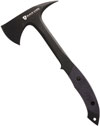|
|
|
 |
|
| Hanwei Samurai Blade Display (OH2154) |
Points: 35
|
This is an elegant display articulating the highly skilled process of forging and polishing a high carbon steel Katana blade. Each step in the process is clearly displayed and explained, using smaller (18") versions of Katana blades that have undergone exactly the same processes as full-sized blades. This display is both aesthetically pleasing and highly educational.
Sold Out
|
|
|
|
|
|
 |
|
| Hanwei Bamboo Mat Wakizashi (SH2448) |
Points: 20

|
Our Bamboo Mat Wakizashi features a chu-kissaki blade of Hanwei's own high-alloy HWS-2S steel, which combines impressive performance with a striking O-choji hamon. This steel is made in Hanwei's new factory, with high-tech equipment, producing a very pure, advanced-metallurgy blade with excellent edge-holding capability and resilience.
The fittings feature a bamboo-themed black iron tsuba, textured in a bamboo mat design with a jointed bamboo rim and highlighted with gold-tipped bamboo leaves. The fuchi/kashira follow the same theme and the golden menuki feature a pair of sparrows. The saya is finished in high-gloss lacquer with horn fittings.
Sold Out
|
|
|
|
|
|
 |
|
| Hanwei Lion Dog Katana (SH2439) |
Points: 40

|
The Lion Dog Katana features an O-Kissaki blade of Hanwei's own high-alloy HWS-1S steel, which combines superior performance with an outstanding O-choji hamon. This steel is made in Hanwei's new factory, with high-tech equipment, producing a very pure advanced-metallurgy blade with the best edge-holding capability and resilience of any blade ever produced by Hanwei.
Sold Out
|
|
|
|
|
|
 |
|
| Hanwei Lion Dog Wakizashi (SH2449) |
Points: 25

|
The Lion Dog Wakizashi features an O-Kissaki blade of Hanwei's own high-alloy HWS-1S steel, which combines superior performance with an outstanding O-choji hamon. This steel is made in Hanwei's new factory, with high-tech equipment, producing a very pure advanced-metallurgy blade with the best edge-holding capability and resilience of any blade ever produced by Hanwei. The outstanding performance characteristics of blades forged from HWS-1S steel derive from a combination of the careful selection of alloying elements and a complex processing procedure, basically involving the manipulation of the steel’s carbon content across the blade section. This results in a very tough and resilient blade with a hard, highly abrasion-resistant edge
Sold Out
|
|
|
|
|
|
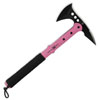 |
|
| M48 Steel Mistress Tactical Tomahawk With Sheath (UC3111) |
Points: 5
|
Prepare to be seduced by United Cutlery's stunning Steel Mistress tactical tomahawk! This lady is all business when it comes to doing her job, featuring a pretty-in-pink fiberglass and nylon reinforced handle that is virtually indestructible.
Sold Out
|
|
|
|
|
|
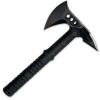 |
|
| Tomahawk United Cutlery M48 Camp Hawk With Sheath (UC3118) |
Points: 6
|
Now you can enjoy all the qualities of United Cutlery's best-selling M48 Tactical Tomahawk in this slightly scaled down M48 Camp Hawk. The head is precision cast of 2Cr13 stainless steel with a heat-treated black finish and attached to the 30% fiberglass and nylon reinforced handle with sturdy metal bolts. The 3" blade is ideal for all of your lighter duty chopping, slashing and breaching applications.
Sold Out
|
|
|
|
|
|
 |
|
| Tomahawk United Cutlery M48 Destroyer Tactical Tomahawk (UC3153) |
Points: 5
|
New from M48, the Destroyer Tactical Tomahawk is a masterpiece of the "Stronger. Sharper" design that you come to expect from United Cutlery. The 2Cr13 cast stainless steel axe head has a black oxide coating to make it practically impervious. The 4 1/2" blade has a smooth satin finish and a razor-sharp edge. The handle is constructed of an almost indestructible injection molded nylon with a fiber fill. Special grooves are designed into the handle specifically so that paracord can be wrapped around it with ease. A new and improved nylon sheath is included and this tomahawk is 16" in overall length.
Sold Out
|
|
|
|
|
|
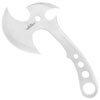 |
|
| Gil Hibben Gen X Pro Throwing Axe With Sheath (GH5043) |
Points: 3
|
Designed by the master thrower himself, this brand new Gil Hibben Gex X Pro Throwing Axe keeps with the Hibben theme, offering rock-solid one-piece stainless steel construction. The fantasy cut-out designs will get some attention, and the razor-sharp blade will sail right into your target with every throw. Don't miss out on this latest Hibben custom design!
Sold Out
|
|
|
|
|
|
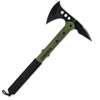 |
|
| United Cutlery Officially Licensed U.S.M.C. Tactical Tomahawk (UC3094) |
Points: 5
|
Brand new from United Cutlery is this Officially Licensed USMC Tactical Tomahawk, built Marines strong with a powerful cast 2Cr13 steel head. The 8" axe head features a 3-7/8" sharpened blade and a wide, upswept spike with a piercing point for supreme breaching and prying applications. The green handle is crafted of 30% fiberglass and reinforced nylon composite material and attached to the head with three sturdy metal bolts for performance you can count on. The cord wrappings provide a secure, slip-free grip that won't let you down. The Marines need a tool they can count on, and United Cutlery delivers in a big way with this USMC tactical tomahawk.
Sold Out
|
|
|
|
|
|
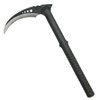 |
|
| M48 Tactical Kama With Sheath (UC3017) |
Points: 5

|
Traditional kamas were widely used among Filipino and Japanese farmers as a sickle-like harvesting implement for reaping crops and rice. United Cutlery's dramatic new interpretation turns the volume way up, and with the M48 name on it, you know you can count on this brand new tactical kama. Featuring cast stainless steel construction honed to a razor-sharp edge with a piercing point, this kama is completed by a fiberglass and nylon reinforced handle with a textured grip. With this innovative design and the reliability of the M48 brand, this tactical kama can't be beat!
Sold Out
|
|
|
|
|
|
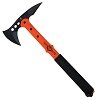 |
|
| Trophy Master Tomahawk (UC3053) |
Points: 5
|
Enjoy the same M48 quality you’ve gotten used to, now with our new M48 Trophy Master Tomahawk. Tactical applications abound with this bright orange tomahawk, only from United Cutlery. It’s lightweight to be carried all day without added muscle fatigue, and the blade of the tomahawk offers a wide, upswept axe blade and a piercing spike on the back end. 3 7/8” blade; 8” axe head; 15” overall.
Sold Out
|
|
|
|
|
|
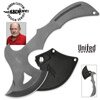 |
|
| Hibben Black Pro Thrower Axe (GH0866B) |
Points: 3
|
"Trigger Grip" handle design guides the hand into the same consistent and accurate release each time it is thrown. Includes genuine leather sheath.
Blade/Handle Material: One-piece, tempered stainless steel.
Blade Thickness: 3/16"
Sheath: Black genuine leather.
Sold Out
|
|
|
|
|
|
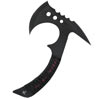 |
|
| Kit Rae Black Aircobra Throwing Axe (KR0055B) |
Points: 5
|
Fantasy knife designer Kit Rae has updated one of his most popular designs in this Kit Rae Black Aircobra Throwing Axe. With a striking fantasy design, this throwing axe is crafted of one solid piece of stainless steel with a black anodized coating, a razor-sharp blade edge, and piercing points. The balanced handle-to-blade design provides superb accuracy when throwing this axe, allowing you to hit your target with precision each time.
One-piece solid stainless steel construction
Non-reflective black coating
Leather wrapped handle
Includes leather blade sheath
Measures: 4 3/8" blade
10 3/4" overall
Sold Out
|
|
|
|
|
|
 |
|
| SOG Fusion Voodoo Hawk (F18-N) |
Points: 3

|
The Voodoo Hawk was designed as a combination of our tactical Tomahawk and FastHawk, featuring an extended cutting head, compact glass-reinforced nylon handle, and metal butt cap. Includes Nylon carry sheath.
Sold Out
|
|
|
|
|
|
|
|
Tags:
swords, sword, katana, wakizashi, tanto, japanese sword, medieval sword, viking sword, japanese swords, medieval swords, viking swords, knife, knives, saber, armour, movie swords, movie replicas, martial arts, sporting goods, sporting equipment,
|




